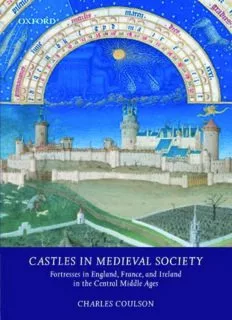
Castles in medieval society: fortresses in England, France, and Ireland in the central Middle Ages PDF
Preview Castles in medieval society: fortresses in England, France, and Ireland in the central Middle Ages
Castles in Medieval Society Fortresses in England, France, and Ireland in the Central Middle Ages CHARLES L. H. COULSON 1 Castles in Medieval Society 3 Great Clarendon Street, Oxford OX26DP Oxford University Press is a department of the University of Oxford. It furthers the University’s objective of excellence in research, scholarship, and education by publishing worldwide in Oxford New York Auckland Bangkok Buenos Aires Cape Town Chennai Dar es Salaam Delhi Hong Kong Istanbul Karachi Kolkata Kuala Lumpur Madrid Melbourne Mexico City Mumbai Nairobi São Paulo Shanghai Taipei Tokyo Toronto and an associated company in Berlin Oxford is a registered trade mark of Oxford University Press in the UK and in certain other countries Published in the United States by Oxford University Press Inc., New York © Charles Coulson 2003 The moral rights of the author have been asserted Database right Oxford University Press (maker) First published 2003 All rights reserved. No part of this publication may be reproduced, stored in a retrieval system, or transmitted, in any form or by any means, without the prior permission in writing of Oxford University Press, or as expressly permitted by law, or under terms agreed with the appropriate reprographics rights organization. Enquiries concerning reproduction outside the scope of the above should be sent to the Rights Department, Oxford University Press, at the address above You must not circulate this book in any other binding or cover and you must impose this same condition on any acquirer British Library Cataloguing in Publication Data Data available Library of Congress Cataloging in Publication Data Coulson, Charles. Castles in medieval society: fortresses in England, France, and Ireland in the central Middle Ages/Charles L.H. Coulson. p. cm. Includes bibliographical references (p.) and index. 1. Castles—England. 2. Fortification—England—History—To 1500. 3. Fortification—Ireland—History—To 1500. 4.Fortification—France—History—To 1500. 5. England—Social conditions—1066‒1485. 6.France—Social conditions—987‒1515. 7. Social History—Medieval, 500‒1500. 8.Ireland—History—1172‒1603. 9. Castles—Ireland. 10. Castles—France. I. Title. DA660.C635 2003355.7 ¢094¢0902—dc212002028261 ISBN 0–19–820824–3 1 3 5 7 9 10 8 6 4 2 Typeset in Minion by Cambrian Typesetters, Frimley, Surrey Printed in Great Britain on acid-free paper by Biddles Ltd, Guildford and King’s Lynn To H.O.H.C., whose challenge—‘What is the use of castles, when they always surrendered if besieged for long enough?’, I have taken so long to meet— And To R.C. (‘Otto’) Smail, who said of some of these ideas in their original form (1970), ‘this must be investigated very carefully; very carefully indeed’: and who wrote ‘the college clock has struck three and you will be closeted with your examiners. The exigencies of the moment mean that you will not be aware of it—but I am sitting here willing you on with all the power at my command’ (1972). Acknowledgements A book long in gestation acquires many debts. Those who are not responsible for the blemishes which remain include the late R. Allen Brown (my research super- visor in 1965–72), Christopher Brooke, Dick (C. N.) Johns, J.G. Edwards and Otto (R. C.) Smail, my first mentor in castellology. To Professor C. H. Lawrence, to my thesis examiners Maurice Keen and Robin du Boulay, and to Michael Thompson, who all read earlier versions in whole or part, I record my gratitude. For encour- agement over many years I am grateful also to Marjorie Chibnall, my once and continual teacher, and similarly to Michel de Boüard, Pierre Héliot, Anthony Emery, Arnold Taylor, Edmund King, Derek Renn, John Blair, Alf Smyth, Philip Dixon, and to Howard Colvin whose counsel and friendship have been most generous. I have benefited also from discussions with Eric Fernie, John Kenyon, Katharine Keats-Rohan, Susan Reynolds, David Crouch, Robert Liddiard, Matthew Strickland, John Goodall, Pamela Marshall, Jean Mesqui, Marie-Pierre Baudry, and especially with Ann Williams, David Roffe, David Dumville, Vivien Brown, and from the fellowship of the annual Anglo-Norman Studies Conference at Battle. Membership of the Castle Studies Group has also brought many advan- tages. My colleague Richard Eales at the University of Kent has been a generous friend and advisor for many years. To him, to Malcolm Barber, to Michael Jones, and to Michael Prestwich I owe many suggestions for improving the final version of this book. Terry Barry has identified some Irish castles for me. The editorial support at the Oxford University Press, especially of the History Commissioning Editor Ruth Parr, of the copy editor Jeff New, and comments by the Referees to whom it was submitted and the typing of Sally Hewett have been no less impor- tant. Where illumination has failed me the fact will be obvious but none of these are responsible. No one has done more to sustain such illumination as I possess than my wife Anne. Nonington Easter 2002 Contents INTRODUCTION 1 PART I. CASTLES: ANCIENT, VARIOUS, AND SOCIABLE 1. A FRESH LOOK AT EARLY CASTLES 15 1. Fortresses in Transition 16 2. The Carolingian Response to Invasion 19 3. Castles and Social Reconstruction 24 2. VARIETY VIOLATED: SOME CONCEPTUAL PROBLEMS 29 1. The Modern Construct of ‘The Castle’ 30 2. Some Contrasts With the Sources 42 3. Castellaries Were Also ‘Castles’ 49 3. SOME SOCIAL RELATIONS OF ‘CASTLES AND FORTRESSES’ 64 1. Earthwork and Ashlar: Policing, Hierarchy, and Aesthetics 66 2. Architectural Eulogy and Noble Ambition 76 3. Some Incidentals of the Castle Image 84 4. Conclusions: Part I—Castles ‘For All the Folk’ 91 PART II. CASTLES AND THE PUBLIC INTEREST 1. NOBLE MILITARY ‘LIBERTIES’, ETHOS AND ETHICS 98 1. Weaponry and Architecture 99 2. The Aura and the Abuse of Arms 104 3. ‘Adventures’, ‘Feats of Arms’, and Fortresses 112 4. Castles: Innocent or Guilty? 117 2. PEACEKEEPING AT HOME AND ABROAD 128 1. Fortifying and ‘Purprestures’, 1217–c.1274 128 2. Pacification and Fortifications, 1217–c.1226 135
